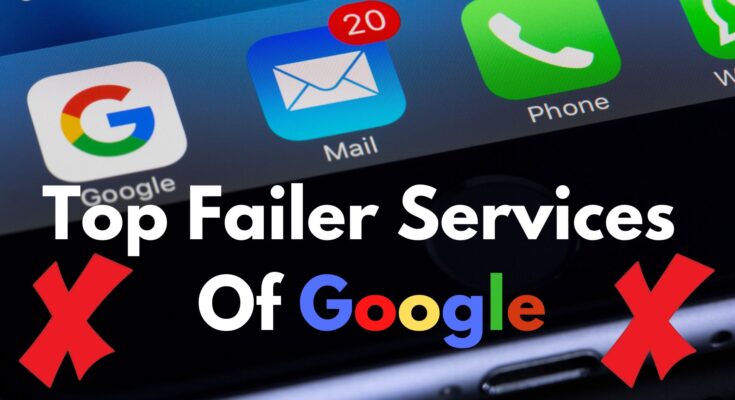Exploring Google’s Wealth and Successes and Failures
Top Google’s Failed Products – Google is known as a massive and successful company, with billions of dollars in profits coming from search engine advertising and its popular products like YouTube, Gmail, Google Maps, and the Android operating system and Pixel smartphones. While these products bring in significant profits for Google, the company has also had its share of failures. Google has had more than 200 failed projects in its history. In this article, we will take a look at some of the well-known successes and failures of the company.
Despite its successes, Google is not immune to mistakes and setbacks. Its management is constantly seeking to increase profits, and the company has had to close several products for various reasons. Some examples of Google’s failed products include the Cloud gaming service, which was announced for closure in September and will shut down in January 2021, and Google Wave, a confusing collaboration tool that was discontinued in 2010. Google has also had failures in the social media space, with products like Google Buzz, Google+, and Google Allo all being shut down due to low usage or data breaches.
However, Google has also had numerous successful ventures. Its search engine is the most widely used in the world, and YouTube has become a dominant platform for video sharing. Gmail, Google Maps, and the Android operating system have also proven to be popular and profitable products for the company.
Despite its failures, Google has continued to innovate and find success with new products. However, it’s important to remember that not all ventures will be successful, and even the biggest companies will experience setbacks.
Google’s Cloud Gaming Service: An In-Depth Look at Its Failure
In September, Google announced that it would be closing its Cloud gaming service, set to shut down on January 18th of next year. Despite attempts to attract a large audience, the service was never launched in Russia and faced issues with payment and performance. The Google Stadia allowed users to play top games without the need for an expensive set-top box or powerful PC, as the game ran on Google servers and the picture was broadcast to TVs, computers, or even Google Pixel smartphones. However, users had to purchase a starter kit, which included a gamepad and Chromecast Ultra TV set-top box, and a subscription for 4K gameplay. In addition, any titles not included in the starter kit had to be purchased separately, even if the user had previously bought the game.
So why did the service fail? It’s not clear why Google was unable to attract enough developers to its platform or why it closed its studios in February 2021 without releasing any projects. It’s possible that the financial motivation for developers was too low or that users were unwilling to purchase additional hardware and games specifically for the Stadia platform. It’s also possible that the lack of availability in many markets hindered the service’s success. Unfortunately, without more information from Google, it’s difficult to pinpoint the exact reasons for the failure of the Cloud gaming service.
Google’s Play Music Failure and Transition to YouTube Music
Google launched its Play Music service in 2011, pre-installing it on almost all Android smartphones. The service allowed users to listen to their music collection and purchase new music, which would be regularly updated. At the time, streaming was becoming more popular, and Google had the opportunity to become a major player in the market thanks to the widespread use of Android devices. However, over time, the service faced numerous issues, including control panel buttons that went beyond the screen and bugs that caused the application to crash or not display downloaded tracks from a PC. In 2020, Google transitioned Play Music to YouTube Music, which had already existed for two years but did not allow users to transfer their libraries. The fact that Google had two separate music streaming services for some time is a testament to the company’s struggles in the market, as it tried to transition users from one failed service to another. However, many users were not willing to wait for the new service to improve and instead turned to competitors like Spotify and Apple Music.
Google Plus
Google launched its social network, Google Plus, in 2011 to create a competitor to Facebook. The company poured resources into the project, with over a thousand people working on its development. Google Plus provided users with tools for video conferencing and photo editing, but these features were not in high demand and users were hesitant to leave their established social connections on Facebook. In addition to poor user engagement, Google Plus faced a major security issue in March 2018 when a vulnerability in the network’s security system led to the data of hundreds of thousands of users being leaked. Google initially attempted to hide the issue, but it eventually became public knowledge. The company released a patch and assured users that only non-critical personal data was at risk, but the damage to the social network’s reputation had already been done. Google Plus ultimately failed to compete with established social networks and was shut down in 2019.
The Failures of Google’s Hangouts and Google Allo Messengers
Google’s messaging services, Hangouts, and Google Allo were unable to compete with popular options like WhatsApp and Telegram. Hangouts struggled with a non-intuitive interface and a lack of popularity among users, while Google Allo copied the functionality of WhatsApp but failed to attract a large user base. The company’s inability to focus on one product and bring it to perfection may have contributed to the failure of these messaging services. Despite offering useful features like video conferencing and file sharing, they were unable to draw users away from established options.
Google Reader Failer
Many users still mourn the loss of Google Reader, an RSS aggregator that was active for 7 years and allowed readers to view articles from news sites and blogs in a timeline. When rumors circulated about the closure of the project, users even created electronic petitions to save it. The most popular of these petitions gathered 100,000 signatures. It is believed that Google decided to close Google Reader to redirect users to its social network, Google Plus. However, the move was met with disappointment and nostalgia from loyal Google Reader users.
Picasa Failure
In 2015, the release of Google Photos cloud storage marked the beginning of the end for Picasa, a desktop utility for storing and editing photos. While Picasa allowed users to upload photos to the network, its main appeal was the ability to work offline on a desktop without a mandatory network connection. This made it convenient for users to quickly download and edit photos from an SD card, and many even used it as a replacement for graphic editors due to its simple editing features and free price tag. However, as the popularity of cloud storage grew, the demand for a standalone photo storage and editing utility like Picasa dwindled. Despite its initial success, the resource Nol, a site where users had to prove their expertise in a particular field to earn money, failed to gain traction due to its outdated interface and lack of perceived value by users. With over 200 failed projects in its history, Google has had its share of successes and failures in the tech industry.
Conclusion
Google has had many failed projects, but the company’s financial stability allows it to survive and move on from these failures. This lack of risk may lead to some Google services being developed carelessly. In addition to internet services, this also applies to their hardware development, such as the Google Glass and the unreleased Project Ara modular smartphone. In the second part of our video, we will discuss these failures and more. Make sure to like and subscribe to our channel for more frequent and improved content. Have a good evening.



![Menyoo Trainer PC v1.0.1 [Single-Player Trainer Mod]](https://modylite.com/wp-content/uploads/2024/03/Menyoo-Trainer-300x170.jpg)

Leave a Comment